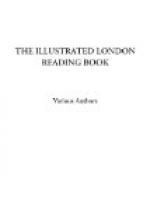ADDISON.
* * * * *
ODE TO ST. CECILIA.
[Illustration]
Now strike the golden lyre
again:
A louder yet, and yet a louder
strain.
Break his bands of sleep asunder,
And rouse him, like a rattling
peal of thunder.
Hark,
hark, the horrid sound
Has
raised up his head,
As
awaked from the dead,
And
amazed, he stares around.
Revenge, revenge, Timotheus cries,
See the Furies arise:
See the snakes that they rear,
How they hiss in their hair,
And the sparkles that flash from their eyes!
Behold a ghastly band,
Each a torch in his hand!
Those are Grecian ghosts, that in battle were
slain,
And unburied remain
Inglorious on the plain.
Give the vengeance due
To the valiant crew.
Behold how they toss their torches on high,
How they point to the Persian abodes,
And glitt’ring temples of their hostile
gods!
The Princes applaud, with a furious joy;
And the King seized a flambeau, with zeal to destroy;
Thais led the way,
To light him to his prey,
And, like another Helen, fired another Troy.
Thus,
long ago,
Ere heaving bellows
learn’d to blow,
While
organs yet were mute;
Timotheus, to
his breathing flute
And
sounding lyre,
Could swell the soul to rage,
or kindle soft desire.
At last divine
Cecilia came,
Inventress of
the vocal frame;
The sweet enthusiast, from
the sacred store,
Enlarged the former
narrow bounds,
And added length
to solemn sounds,
With nature’s mother-wit,
and arts unknown before.
Let old Timotheus
yield the prize,
Or
both divide the crown:
He raised a mortal
to the skies;
She
drew an angel down.
DRYDEN
* * * * *
SATIN BOWER-BIRDS.
The Satin Bower-Bird was one of the earliest known species in the Australian fauna, and probably received the name of Satin Grakle, by which it was described in Latham’s “General History of Birds,” from the intensely black glossy plumage of the adult male. But, although the existence of this bird was noticed by most of the writers on the natural history of Australia subsequent to Latham, it appears that no suspicion of its singular economy had extended beyond the remotest settlers, until Mr. Gould, whose great work on the “Birds of Australia” is known to every one, unravelled the history of the bowers, which had been discovered in many parts of the bush, and which had been attributed to almost every possible origin but the right one.
The bower, as will be seen by the Illustration, is composed of twigs woven together in the most compact manner, and ornamented with shells and feathers, the disposition of which the birds are continually altering. They have no connexion with the nest, and are simply playing-places, in which the birds divert themselves during the months which precede nidification.




